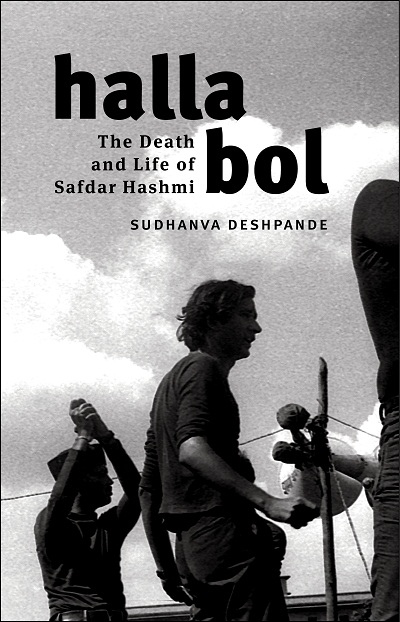Before I read this book, I only had a passing knowledge of Safdar Hashmi- a street theatre artist, a north-Indian leftist, always spoken of in deep tones of respect by the people who knew of him, and some one who was killed during one of his street performances. I use the word killed because as Sudhanva himself says “Safdar was not assassinated, for that presupposes a specific target. His was a political murder. Mukesh Sharma and his henchmen were no evil geniuses; they were local thugs…Fear was the currency they traded…Their target was the workers’ movement, which was a direct threat to their fiefdoms. This was an instance of class struggle”.

Safdar Hashmi personified the mythic, romantic idea of the intelligentsia. In my understanding, he was one of those rare, compassionate and talented humans who dedicate their lives to a philosophy that encompasses a world beyond themselves. For him street theatre was a craft, an engine that delivered his philosophy, that it was not only an agitprop but also a medium of taking “healthy entertainment to the culturally starved people“. Before this book, I did not even know when he was killed (1st January, 1989). Such is the degree of loss of narrative that play out every day in the Indian political landscape. Or maybe I am a late-bloomer.
The book also gives a lay of the land to the history of the intellectual left, student politics and trade union activism in northern India. This is a very important I think because, in my humble and naive opinion, the history of the left is not accessible to large swathes of the Indian polity. Especially after liberalisation and the systematic dismantling of editorial driven content in India- the country’s media has now become a wasteland of blatantly non-progressive ideas.
This is tragic for a country that needs to ask some very important questions, including why it is always a small number of people who accumulate, extract and exploit the commons to such an unbelievably obscene degree. That set me thinking about the difficulty of the task, penetrating the impenetrable world of the Indian body politic. Take caste, for instance- a subject that Sudhanva also acknowledges even Hashmi had difficulty in building a performance on. The short chapter where this is discussed offers what Hashmi said about the complexity and difficulty of mounting theatre focused on caste, but according to me, does not state the obvious elephant in the room–almost all members of the troupe at that point of time came from forward castes or classes. While they were able to “condense Karl Marx’s opus, [Das] Capital, into a 13-minute treatise“, clearly none of them had the lived experience of the suppressed caste in India. It seems it was not until 2016 that the troupe was finally able to produce play on caste –which is fair, If there is one thing that I have learned from my stint in Australia, it is that we must never take away the last bastion of the oppressed–their right to self-representation and self-narration.
Going back to the book- Sudhanva writes with an insider’s perspectives, starting from the day Safdar was killed and going back into the months and years preceding the event. It is built mostly on his own recollections as a young undergraduate who was getting more involved in Janam, the street-theatre troupe that Safdar founded. In Hindi/Urdu, Janam mean Birth, but it is also the diminutive of Jan Natya Manch– People’s Theatre Front.
The insider perspective gives the book a cosy, collegiate feel as the author takes us behind the scenes while he himself navigates and learns the landscape, name-dropping many figures of India’s left movements. I particularly loved the description of the process of script-writing the scenes of Chameli-jaan (a typical name connoting a concubine in north-Indian movies and stories) with another stalwart that I know very little of Habib Tanvir. There is much that is revealed in the semi-bantering and mutually respectful way the two men, Hashmi and Tanvir, interacted. Here you see how they progressed a script from a banal statement of ideology to a layered construct that understood the audience as much as the message it delivered.
Finally the book left me with a curiosity to watch these plays, to read the scripts and to perform. Here I was left a bit disappointed when I visited the Janam’s website. They do not publish the scripts, or atleast I could not find them, and there’s a certain contemporary dynamism that I found lacking unlike say something like the Rosa Luxemburg Stiftung. Should Janam’s scripts not be out in the open, translated, interpreted and performed by anyone? I have done a quick skim of some of the plays that are on video (Aurat, Machine, Halla Bol) and I get a sense that it is possible, that like many of the good ideas of the left in India, this too is slightly in danger of getting ossified as an art-form. We cannot afford to lose this too.
As usual, I have also meandered too far from what is the most important learning of it all, that –his “irrepressible humanitarianism” was a unique flame that stood out, and that should inspire many in dark times we live in. Let us end therefore, on a lighter vein. Did you know that the famous jingle “Padhna likhna seekho–o mehnat karne waalo” (Hindi: “Learn to read and write- o workers“) from the 80s or 90s was composed by Hashmi? What a work of genius this is, an innocuous children’s jingle played on national television (on a scale that is no longer accessible to left ideas in India) that spoke of education as a tool to empower yourselves, and break free from the shackles of injustice.
